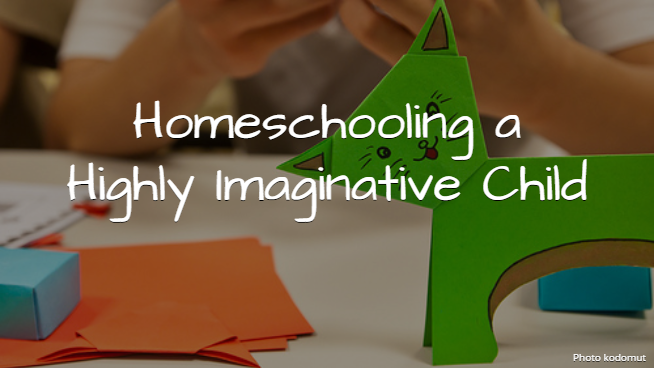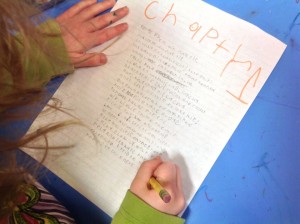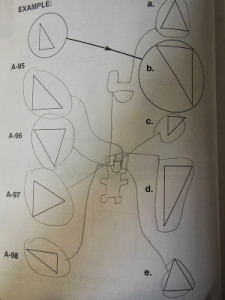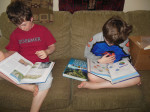 Homeschooling a highly imaginative kid is an interesting endeavor. Creativity is often suppressed with traditional educational models. While challenging, homeschooling a highly imaginative child allows you to embrace the immense creativity of these kids and adapt the learning environment to suit your child.
Homeschooling a highly imaginative kid is an interesting endeavor. Creativity is often suppressed with traditional educational models. While challenging, homeschooling a highly imaginative child allows you to embrace the immense creativity of these kids and adapt the learning environment to suit your child.
Go with the flow
While there are times when an imaginative child just needs to get work done, things tend to work better if you can go with the flow. If my child is in the middle of a project or off in the world of pretend, it is best for me to wait for her to finish. Because I am homeschooling three and work from home, sometimes reality hits and I need to work with my child when I get a chance rather than when she is done with a project. But those situations are not ideal. It is definitely better to go with the child’s flow. Some days we spend a bunch of time learning together and other days she spends a lot of time exploring and learning on her own.
Busy writing a new story
Bringing creativity into subjects
When choosing curriculum or materials for my imaginative child, I attempt to choose items that will engage my child. I don’t focus on grade levels, but on engagement. I ask myself if my child would find the materials interesting. With a highly active imagination, the curriculum chosen needs to be engaging if I want to attempt to compete with my child’s imagination.
Sometimes a creative child may liven up a subject. Doodling, going off on tangents, and deciding to complete the work in a different manner than expected are par for the course. Sometimes this means that a subject that could take 10 minutes to complete ends up taking an hour with all of the detours an active imagination can bring.
A simple matching exercise livened up
Allow time for self-exploration
The more imaginative the child the more wiggle room there needs to be. Full days and school schedules that have time deadlines may not be the best fit. I have two very imaginative children and one works well with a time deadline and the other does not. They both need wiggle room in their day to explore topics of interest.
For my kids this means that I need to allow time for my younger imaginative child to rotate between playing and formal schooling during the day. Also, I try to keep a balance so there are at least some parts of formal schooling that she really enjoys. For my older child this means that there needs to be a portion of the school day that he finds enjoyable with the last thing of the day his favorite thing of all.
Embrace the imaginative
Sometimes you just need to embrace the imaginative in all its silliness. When my daughter was having trouble remembering the right way to write the letter s, she discovered that when she made it correctly, it knocked me to the floor. Needless to say, she was very careful writing s after that because she wanted to see me fall down quite often.
A 3.5 year old boy named Frankel often accompanies my 6.5 year old during the school day. He loves to have my daughter read to him. I play the part of Frankel while my daughter plays the part of a librarian reading books at story time. She stops reading every couple of pages so Frankel can ask questions. I take advantage of this by asking some questions that give me more insight into her understanding of what she read. My daughter adores reading to Frankel. She doesn’t so much enjoy reading to me, but when I change into a little boy she becomes engaged and ready to read.
Flexibility
Flexibility is a must. Some days are days where my kids do an amazing job teaching me what doesn’t work. Homeschooling an imaginative child is about continual adjustment. When something isn’t working, I attempt to make some changes to our day. Some days I drop things we were “supposed to do” as we go off on a tangent or two.
Homeschooling a highly imaginative child is challenging and interesting at the same time. Some days I find that I need to “stand on my head” and think outside the box to figure out a way to engage my children. Many times things fall flat, but we try again next time because I don’t believe the best way to educate an imaginative child is to make him or her conform to standard educational methods. I believe that the best way to educate a highly imaginative child is to adapt materials and methods to the child.










After reading this i now know that i am dealing with an imaginative child. Most of his worksheets look just like that! He is only 5 and we are finishing up K this year and use a unit study literature rich type curriculum, all about reading 1, horizon math, and a grade based workbook for basic skills. Over
Love this! Thanks for validating what I felt was right for my little guy!!!
Reason #234 homeschooling is awesome :). I was that creative child who doodled constantly in PS (except when I had a rigid teacher). I love the freedom of home!
I’m homeschooling a 5-year-old dog named Puppy right now and his 15 stuffed friends :). He answers everything in a bark then translates for me. He gets lots of doggie treats (cereal) throughout the lessons. We make liberal use of hesd scratches and pawprint stickers. It’s fun for me too because I get to use my creative mind to come up with new ways to enter into his play and delight him.
Love this. My youngest has the best imagination and we’ve certainly had to tweak our learning to match his needs.
You’ve pretty much just summed up why I homeschool, especially my middle one! He has the busiest brain of anyone I’ve ever known and I love that some days we can get school work done, but others he can run wild and be creative! When he was younger all of his matching activities looked like yours!